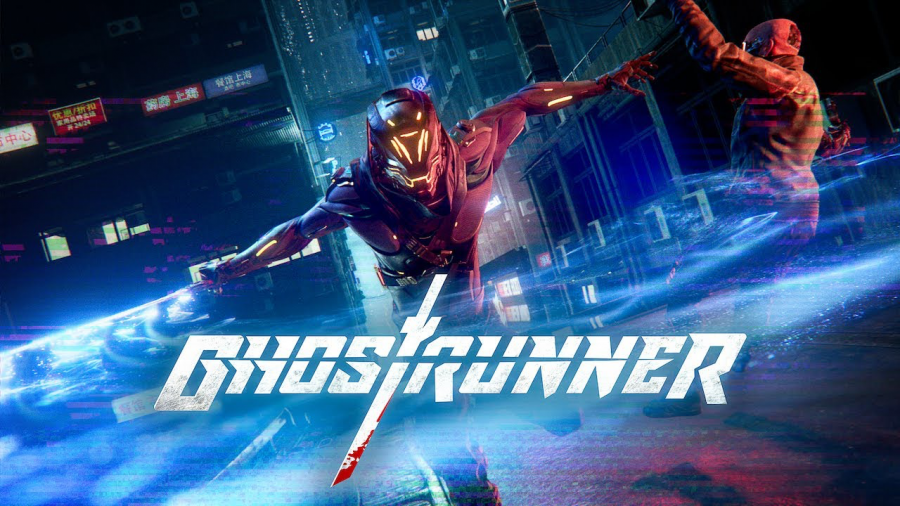“Ghostrunner” excels at cyber-ninja immersion
A promotional photo for “Ghostrunner,” a cyberpunk action video game released in 2020 .
With so many amazing games coming down the pipeline, there are bound to be a few hidden gems overlooked by casual gamers. One such gem is “Ghostrunner,” a fast-paced first-person slasher set in a dystopian cyberpunk future. The player takes on the role of the last Ghostrunner, a cyber-ninja warrior fighting back against the oppressive forces of Dharma City.
Throughout the game, the Ghostrunner must run, jump and slash his way through each level, or section of the tower, facing off against an onslaught of obstacles and enemy types and only occasionally slowing down to strategize. In that sense, the game excels at immersion, truly making you feel like a cyber-ninja.
The most distinguishing feature of the game is its one-shot mechanic, where any attack from either the player or the enemy results in instant death. You will die a lot, but thankfully the checkpoint system and instant load times prevent this from ever getting frustrating. As such, the game heavily emphasizes trial and error, encouraging players to carefully plan their routes while never forcing them to stick to one particular path or play style.
This is accompanied by a phenomenal parkour system that puts “Assassin’s Creed” to shame. Wall-running, curb-sliding and line-grappling are only a few ways the “Ghostrunner” fully utilizes his environment. With each passing stage, the formula drastically changes to uniquely suit the environment; for example, when you have to time your rope swings upwards while dodging a barrage of tower lasers. It perfectly walks the line between keeping players guessing and giving them a fun set of tools to master and explore.
Along with the parkour is the game’s fantastic melee combat. Armed with only your katana, or sword, fighting really comes down to studying the patterns and placement of enemies in the given location. Once you know exactly how to dodge, it all comes down to closing in for an always satisfying one-shot. While there isn’t much depth beyond that in terms of typical enemies, each blow you land never ceases to entertain as you watch those aggressively foul-mouthed soldiers blast away in chunks. When it comes to bosses, fighting is slightly more in-depth, my favorite being a precision-focused sword fight against a compromised Ghostrunner, where you have to time your swings down to a tee.
As you progress, the Ghostrunner also gains access to four energy abilities, each one equally fun to use. The first among these is Blink, which allows you to lock onto multiple targets before initiating a speed dash, instantly slashing through your targets. Next up is Tempest, which boils down to using the Force to knock away enemies off buildings. Then there is my personal favorite, Surge, which unleashes a projectile energy slash from your sword to slice away enemies from a distance. Finally, there is Overlord, which lets players hack enemies into allies.
Although these abilities are already game-changers, they, along with all of your basic game abilities, become increasingly satisfying to use as you toggle with the upgrade system.
It comes in the form of a “Tetris”-like minigame where players mix and match individual components to create their ideal builds. The “Tetris” aspect shines in, making the players pick and choose critical parts based on how they will fit on the grid, limiting certain ability matchups to keep the players from becoming god killers. While more parts of the grid open up as you progress, even by the end, you will not be able to input every upgrade at once. This encourages the game’s replay value through different possible builds.
If there are any real criticisms I had over my first eight-hour run, I would say that the game lags slightly at the start of each level, at least on PC. Despite scaling back most of the game’s settings, I was still met with stuttering as the game built up its textures and environments. I am sure this can be fixed with a patch, but this is a massive issue for a game that prioritizes fast-paced movement. Thankfully, I only seem to encounter this for a short while once the game has first booted up.
Overall, I would highly recommend picking up “Ghostrunner” in a couple of weeks. Wait for another patch and then grab it on whatever console or site you fancy. There are several great games out at the moment, and this one deserves to be played.











